The DS130DLHV is a high voltage (HV) digital servo
built on a tough hybrid case of aluminum and plastic. Equipped with
dual ball bearings and all-metal gears (for durability), it outputs 130
oz-in (+8 pounds of force) and has a transit time of 0.17sec/60°. This
is what's called a standard-size servo - meaning it fits most remote
control models. Competing with similar
products from other manufacturers, the $30 price puts it in the middle of
the pack. To help figure out whether these are the servos for your next project, we've grouped information into various tabs. For example;
- Specs - useful if you're curious about the raw numbers, dimensions, etc.
- Comparison - a guide regarding how it compares to other products.
- TL;DR - gets down into the weeds with the nitty gritty - it's for the detail-oriented.
- Reviews - short and sweet with real names and places - no BS.
It's our opinion - unless you're a fanboy - it'll become glaringly obvious this servo plays in a different league. If you agree, then it becomes the yardstick against which you
measure the others. Once you do this, it becomes the servo for your next project. Showing you why it's worth every penny involves the basics of show-and-tell so our game plan revolves around altering your perception regarding cost vs. value.

INTRODUCTION:
Part of what makes the ProModeler DS130DLHV better than competitors is that unlike hobby-grade
servos, it's built to meet military standards (and subjected to these tests).
MIL-STD-810G-Part 16
- Shock - Test Method 516.6
- Vibration - Test Method 514.6
- Rain - Test Method 514.5
In part, this is due to the requirements of our primary customer. However, because we're modelers and have knocked a servo off a workbench, experienced crashes, and know a thing or two about engine vibration (plus how a summer afternoon pop-up
rain shower may drench a model before landing), it means these tests are important for civilian users as well. So if you're looking at another servo, one which offers similar performance and pricing, but hasn't been tested to military standards, which would you rather have? However, beyond making servos expressly designed to survive the abuse encountered in the real world, there are important ownership considerations.
Ownership Considerations:
Competition pilots - especially those who fly precise maneuvers - prefer ProModeler servos because we use MIL-SPEC components plus a genuine Japanese Nobel-brand potentiometer. Others? They're satisfied with a cheap clone, an inductive pickup, or some other cost saving potentiometer.
Also, and especially important for IMAC and pattern competitors who fly a
lot and thus, go through and R&R their servos each winter, we offer
spares. And not just the case and gears like everybody else, but the spares that count - to include the potentiometer and the servo motor. Plus little things like o-rings, bolts, and even the label - and instead of being forced to return your
servos for service, isn't it nice to save money through DIY?
Why the emphasis on competition pilots? It's because these folks fly 30 times a week (and do it week-in, and week-out), e.g. it's de rigueur to practice 3X a week and twice on weekends. They know
potentiometers, even million-cycle ones like we use, are a wear item. Since replacing a potentiometer is easy - a matter of three solder
joints - these highly experienced pilots find our attitude refreshing!
Granted,
most guys won't 'ever' fly enough to wear out our servos . . . but isn't
it nice to be able to buy
these components for restoring your servos to like-new performance without sending them in? Bottom
line? Full spares support is a requirement of military contracts
but a game changer in the world of
civilian-use servos. But there's more, because once you start looking you find many thoughtful touches, like Allen
head bolts instead of Phillips head screws. Yes, it's a minor detail, but for those who believe in taking care of the small things this is yet
another reason to prefer ProModeler servos.
The DS130DLHV servo is
perfect for models ranging in size from .40ci (6.5cc) through to 1.20ci (20cc) giants, and larger depending on how you fly. It's been expressly
crafted to meet your needs whether you're a beginner looking for your
first set of high quality servos, a highly experienced sportsmen attending several fun flies each summer, or an
all out pro.
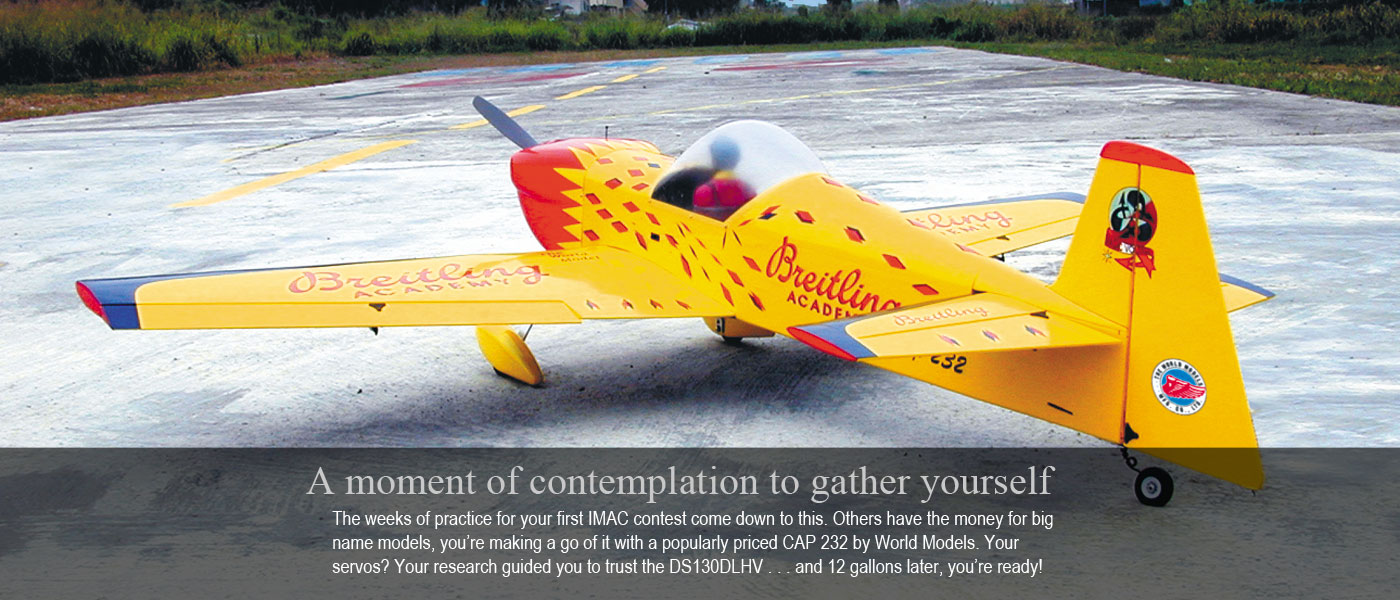

DETAILS:
If
you're an electrical engineer you'll immediately notice we protect the PCB
from vibration with a conformal
coating instead of a little square of foam rubber. Referred to as
potting compound on the civilian side, we call it monkey-snot because
it's such a sticky mess to apply. This stuff is applied to the PCB and
oozes between components and once it sets is what lets our servos thrive
in harsh high-vibration environments. This is an aerospace-grade
technique and it makes ProModeler servos more valuable.
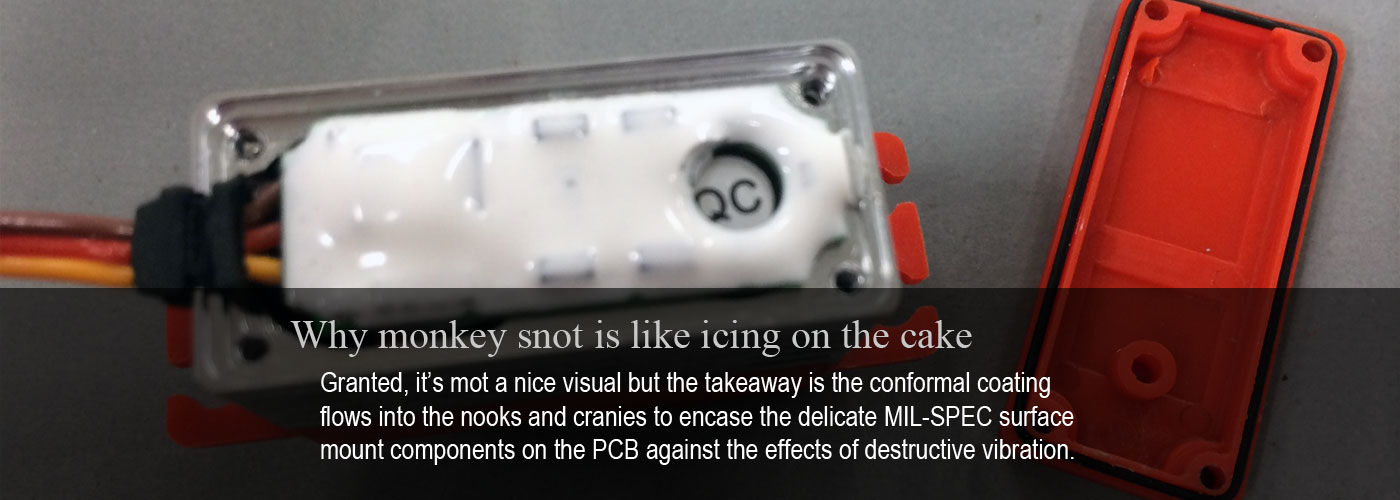

Another area where a ProModeler servos stand out is protection from environmental contaminants, typically dust,
water, and exhaust-oil. The assembly of the DS130DLHV is protected with o-rings - basically at every opening - even beneath the screw heads! We all know how pernicious water can be with respect to penetrating where we don't want it so this detail helps make ProModeler servos better. It's a no brainer.
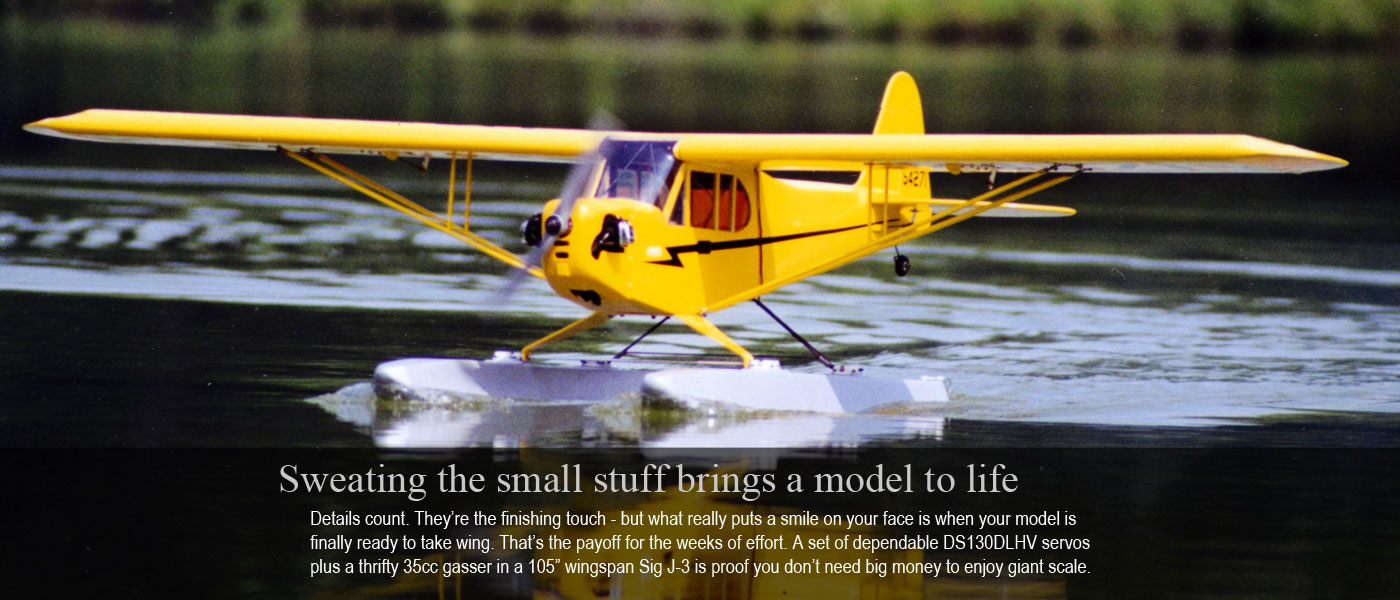

Ever taken a servo apart? The metal gears rotate on steel shafts. The end of the shaft fits in a hole in the case, what's called a pocket. In cheapo servos, the steel fits into a plastic pocket but in a ProModeler servo, there's a brass insert reinforcing the plastic. When you pay a little bit more for a ProModeler servo, this is part of the reason why. As long as it moves, we know modelers won't throw anything away . . . so we produce ProModeler servos with the expectation of a service life measured in decades!
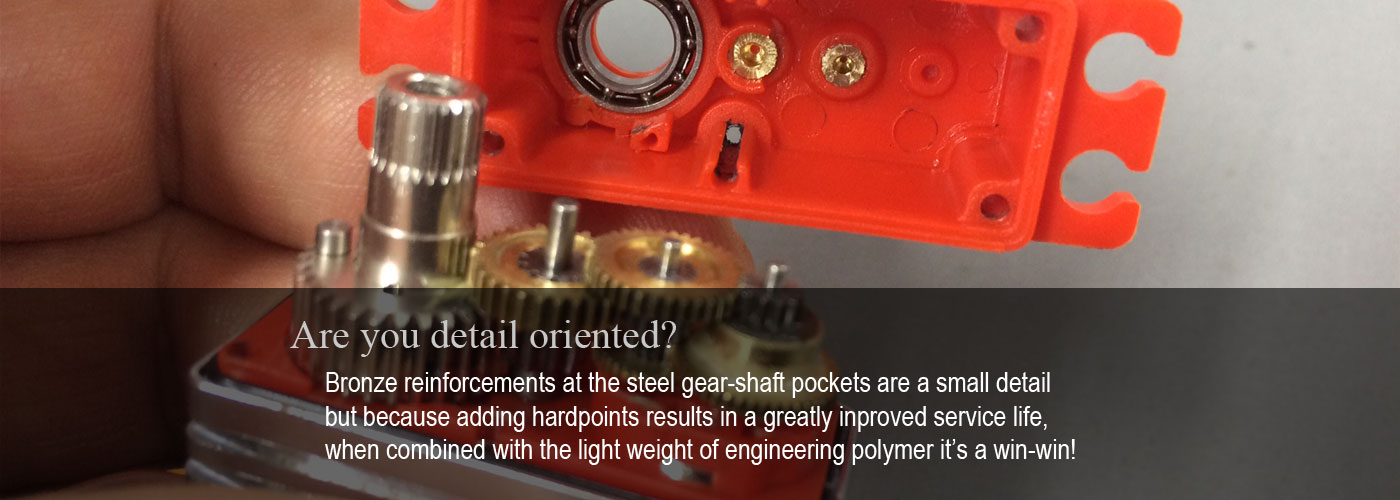

USE CASES:
So
who
uses these servos? In light of the MIL-SPEC and MIL-STANDARD test methods, you won't
be surprised to learn the government has driven a lot of our product
development. They're our biggest customer. So are universities, plus
commercial UAS operators in agricultural and pipeline inspection ops. We've branched out to the civilian world, so our customers now include hobbyists.
This customer is often a highly experienced modeler, but also includes savvy beginners who realize just because the servo will first be used in 40-size trainer doesn't mean you throw them away when you transition to a higher performance model. Anyway, you may use this servo in a wide array of sport
and scale models - with wingspans ranging from about 48" all the way up
to 105". More importantly, the DS130DLHV perfectly demonstrates the difference
between what something costs versus what it's worth.


SUMMARY:
At
heart, servos offering 130oz-in of torque and transiting in the
0.17sec/60° range aren't hard to find. The trick is finding another that
offer everything these do. You won't and it's due to the attention to detail. There isn't a better servo - for the money - on the planet. Period. No other servo offers
this level of tank-like durability and nobody else lets you completely rebuild them yourself. So if you're
mechanically 'ept' this is yet another consideration if you can do basic soldering (naturally, you can also send them to us for R&R if you aren't comfortable doing these things).
Better
components. Better servos. The formula is simple. Decisions regarding
what goes into ProModeler servos aren't made in accounting to optimize
price and profit, but in engineering. This servo isn't sold for $20 because it costs more than that to make, but in light of what goes into it - $30 is a pretty reasonable price. Simply put, this is the best servo available for the money. Add a set to your cart. Do it now because you're going to love them!

Other Resources
For detailed specifications and dimension drawings, select the Specs tab above. Also, there's an even-handed look at the competition in the Comparison tab. Meanwhile, TL;DR
is chock full of nitty-gritty details - where we disassemble and show you this servo side-by-side with a popular competitor. If you love delving deeply
into stuff some find too tedious to read, don't overlook this tab.
Note: operating voltage is 4.8-8.4V, but optimal performance is obtained with a 2S LiPo instead of a BEC. This is because LiPos deliver the required current without voltage spikes, noise, or otherwise adversely affecting the delicate avionics (25C or better is recommended). After all, synthetic orange colored Tang may have gone to the moon, but it doesn't compare to freshly squeezed orange juice. Same thing when it comes to feeding your avionics!
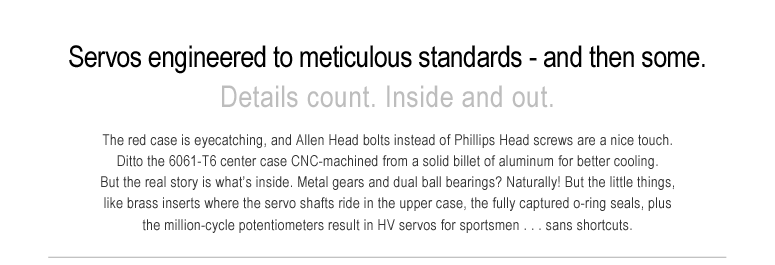
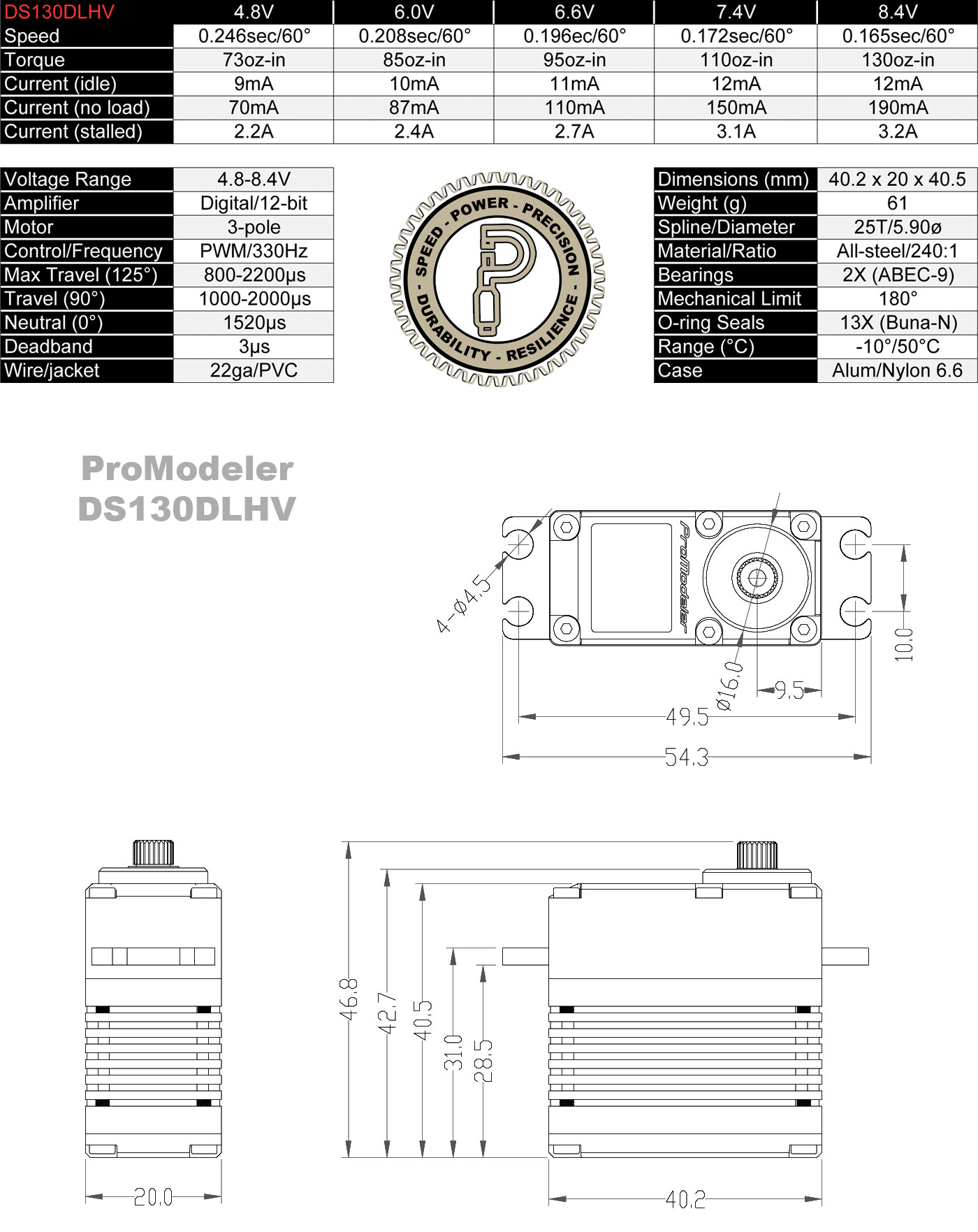
When customers mention a competing
servo, they're basically asking our opinion regarding how it compares to our DS130DLHV. What follows is a summary of our
observations. This is offered in hopes of informing your opinion while
at the same time trusting you'll judge us to be blunt . . . but fair.
The
workhorse of the servo industry are standard-size digital-servos
equipped with 3-pole Fe-core motors. They're used for everything from
40-size trainers through giant scale models. Thing is, figuring out
which servo is best can be hard because there are so many similar servos on the
market. The purpose of this page is to compare and contrasts the
ProModeler
DS130DLHV digital servo with other high quality servos. That said, this
isn't a
comprehensive market survey because we're not including what are, in
our opinion, junk servos.
This, in part is because we're modelers
like you. Thus, we place a high value on our models. But it's also
because we've been at this long enough to grok the the real risks posed
by servo failure resulting in an
out of control model. look, there's no nice way of saying this but when a
nice ARF model costs $200-300, an engine is $125-200 (or motor, ESC,
plus batteries are $250), and four good servos are about $120, while we
understand there are some who want to believe they can get good servos
for $60-80, we just don't agree. That said, there's obviously a market
for $15-20 standard-size digital-servos. Thing is, once we eliminate
what makes our servos better (just to make them cheaper), we're not
willing to put our name on it. Bottom line? The servos presented are
ones we'd consider buying for our own use if we
weren't in the servo business.
Finally, please note; because we
don't hide from good competitors, while some of these cost more and
others cost less than ours (and some actually outperform us in some
manner), we nevertheless show them because we believe you'll judge ours
are, on balance, the better servo for you. Anyway, servos are listed
alphabetically.
- Futaba S3071HV - $49.99
- Hitec HS-5645MG - $39.99
- Hitec D-645MW - $39.99
- Hitec HS-5646WP - $54.99
- Spectrum A6150 - $36.99
 First
up is Futaba's S3017HV. As modelers we've had a lot of experience
with
Futaba-brand servos. They're well built and reliable. The
S3017HV upholds the tradition.
Sure, theirs touts S.Bus as
a native feature but we counter with a) if you're not smart enough to
plug a servo into the appropriate channel of your receiver you have
bigger issues to worry about and b) they offer adapters for non-native
S.Bus servos so it's our opinion; for the vast majority, it's just a
gimmick. Meanwhile the DS180DLHV offers more torque, the same speed, and costs less, plus we feel ours is built better.
First
up is Futaba's S3017HV. As modelers we've had a lot of experience
with
Futaba-brand servos. They're well built and reliable. The
S3017HV upholds the tradition.
Sure, theirs touts S.Bus as
a native feature but we counter with a) if you're not smart enough to
plug a servo into the appropriate channel of your receiver you have
bigger issues to worry about and b) they offer adapters for non-native
S.Bus servos so it's our opinion; for the vast majority, it's just a
gimmick. Meanwhile the DS180DLHV offers more torque, the same speed, and costs less, plus we feel ours is built better.
Here's why; they fit the steel gear shafts
directly into a plastic pockets (within the top case). we designed bronze inserts to reinforce our plastic top case. This is
important because the useful working life of a servo can easily exceed
10 years. This means the question of which servo will still be nice and
tight is a no-brainer.
Similarly, Futaba decided 4 screws was good
enough to hold it together. We, on the other hand use 10 because we
achieve a stiffer assembly. Stiffer is better for keeping the gears in
perfect mesh even under high loads. Again, something of a no brainer.
Added to which, instead of Phillips heads, our
servos use Allen-head screws.
However, a key difference is Futaba
rely on a plastic center section for this servo while we believe you get
more for your money with a center case that's CNC-machined from a solid
billet of 6061-T6 aircraft
aluminum. You get cooling fins too because these help with dissipation
so the motor
lives longer when the servo is being worked hard.
Then there's the PCB
(printed circuit board) which we protect against vibration with a
conformal coating (eyeball the detail photos within the TL:DR tab). And to protect against
environmental intrusion, we seal the DS180DLHV with
thirteen (13) O-rings (versus none for this Futaba servo). Bottom line? Experienced modelers
judge the ProModeler servo to be made better - and if you do too - then
it's game, set, match!
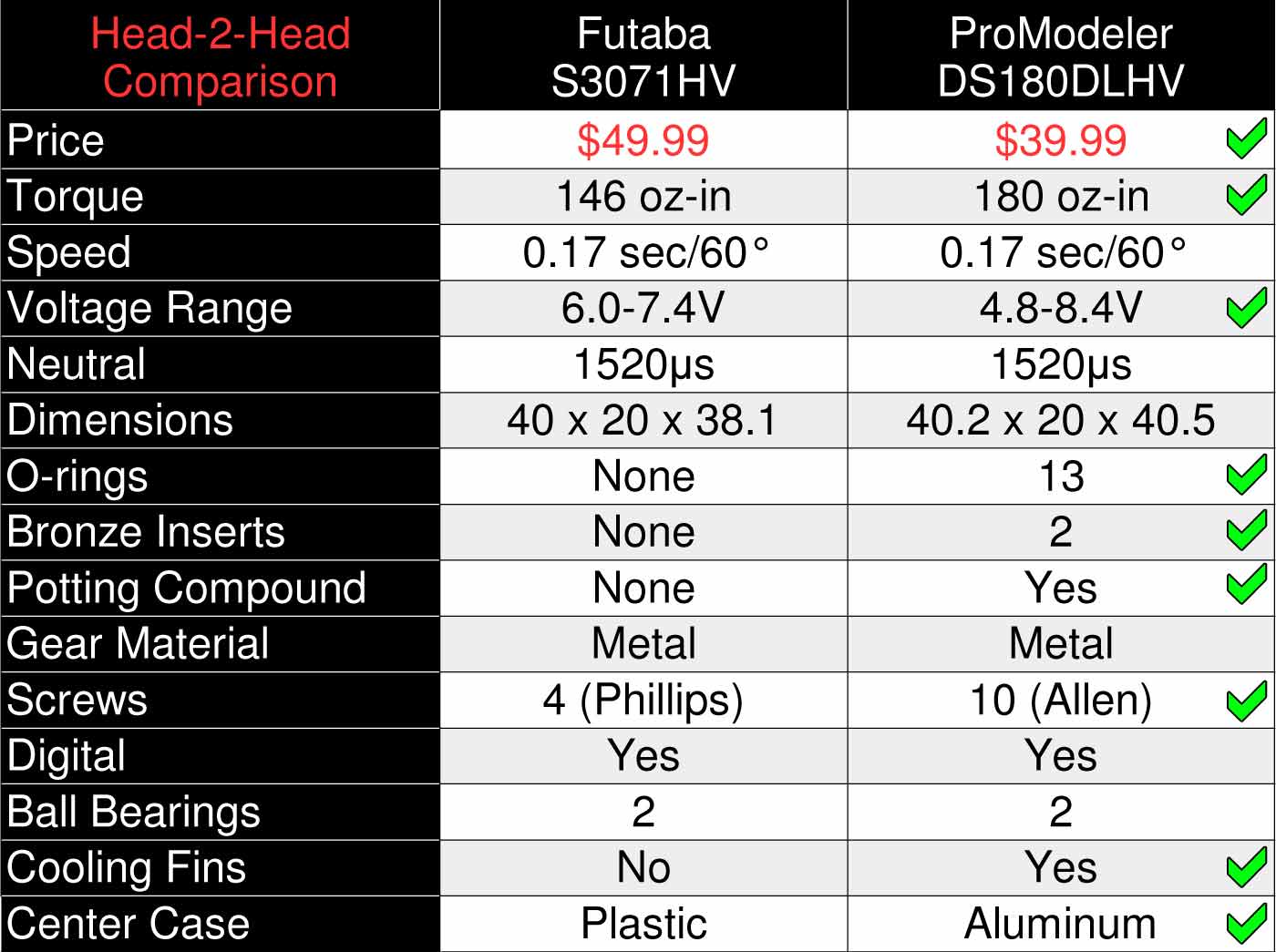
 The
Hitec HS-5645MG has been around a long time. In fact, there's a
reasonably good chance you can see one at any model flying field in
America because it's such a darn good
product (and FWIW, this was our internal benchmark when designing the
DS180DLHV). To the point both theirs and ours offer about the same
torque and speed, and they even cost the same! That said; we believe ours is better.
The
Hitec HS-5645MG has been around a long time. In fact, there's a
reasonably good chance you can see one at any model flying field in
America because it's such a darn good
product (and FWIW, this was our internal benchmark when designing the
DS180DLHV). To the point both theirs and ours offer about the same
torque and speed, and they even cost the same! That said; we believe ours is better.
Here's why; to begin ours is more versatile
because it can be used with a wider range of input voltages. It
also has O-rings
for water resistance - important when you're dodging rain drops from a
pop up rain shower one fine summer day (or perhaps
enthralled by float planes and re-purposing your servos for flying off
water three years from now).
But
what about the
programmability Hitec touts? Well, since you can reverse a
servo and set end points, etc. within the transmitter we fail to see why
it matters that you can also do it within the servo. Basically, it just
isn't that big a big a deal - not like it was back in the day when
transmitters were primitive. Not that it's totally useless, but is it
sufficient
reason to justify buying what's ultimately, considered by many an inferior servo?
Here's
what we mean; beyond water resistance and a wider range of input
voltages, the DS180DLHV has an aluminum center section for better motor
cooling. It also uses 10 Allen head bolts for assembly instead of Phillips head screw. Added to this, it has a conformal
coating on the PCB for better protection against vibration, and the plastic top case has
bronze inserts which reinforce it where the steel gear shafts fit (theirs fit the steel shafts directly in plastic).
Add
one
last thing; when did it become OK t market MG (metal gear) servos with a plastic
gear? We mention this with respect to the HS-5645MG because their 'metal' gear train includes a
plastic gear! It's their part #55016 and FWIW, they're sold in 3-packs
(for whatever
that tells you regarding its durability). Anyway, while it's still being
offered brand new, it seems even Hitec realize its day is passing
because they're making newer versions, the D546MW and the HS-5645WP - but
more about them later. Below is the Head-2-Head match-up between the
DS180DLHV and the HS-5645MG and quite frankly, we believe we run away with another win!
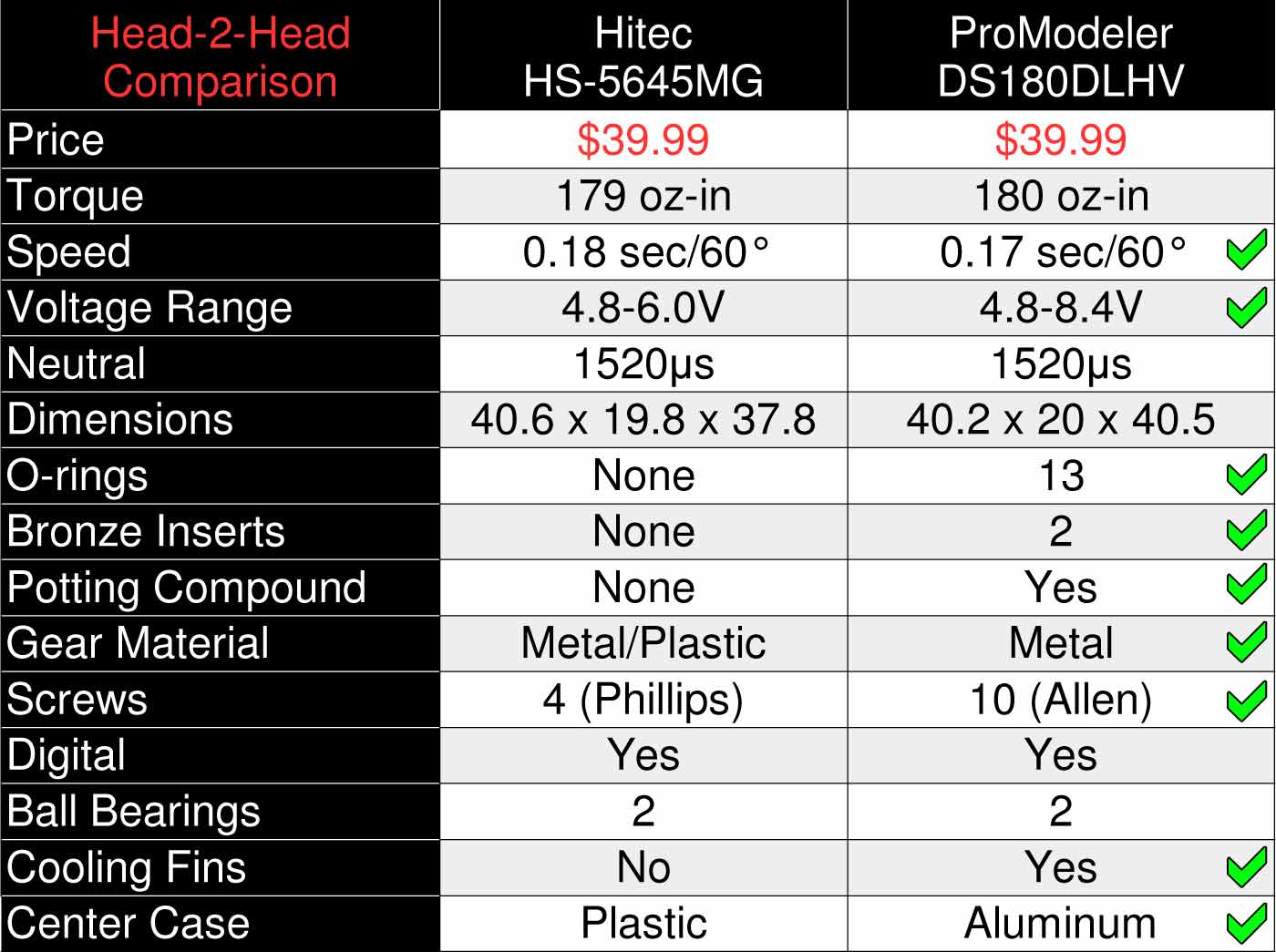
 With
the D-645MW, the torque of the Hitec digital servo remains about the
same as the earlier generation HS-5645MG but they kicked the speed up a
notch - to match ours exactly. Not, if we're being honest, that there's a heck
of a lot of difference between 0.18 and 0.17sec/60° (6%).
The biggest benefit most will realize with the D-645MW is the ability to run off a straight
2S LiPo at 7.4V (nominal). This is nice but we still score a win in this category
because the DS180DLHV lets you operate off a much wider range of input voltage (from 4.8 to
8.4V).
With
the D-645MW, the torque of the Hitec digital servo remains about the
same as the earlier generation HS-5645MG but they kicked the speed up a
notch - to match ours exactly. Not, if we're being honest, that there's a heck
of a lot of difference between 0.18 and 0.17sec/60° (6%).
The biggest benefit most will realize with the D-645MW is the ability to run off a straight
2S LiPo at 7.4V (nominal). This is nice but we still score a win in this category
because the DS180DLHV lets you operate off a much wider range of input voltage (from 4.8 to
8.4V).
Otherwise,
for all intents and purposes, while this is a very nice update to
the HS-5645MG it's by and large a very similar servo (reflected in the
cost, which is the
same-same between this one and their older design - and ours). Frankly,
we suspect few would see
anything worth crowing about because once you consider the conformal
coating on our PCB (for improved resistance to
vibration), the much stiffer 10-bolt case (plus Allen head bolts vs.
Phillips head screws), as well as the 13 O-rings for sealing, and
especially the
CNC-machined aluminum center section, which lets a motor run cooler (for
a
significantly longer lifespan when a motor is worked hard) it's just no
contest when the cost is the same. Especially considering how just
as with the HS-5645MG, the D546MW has a plastic gear within the
gear train (same part number).
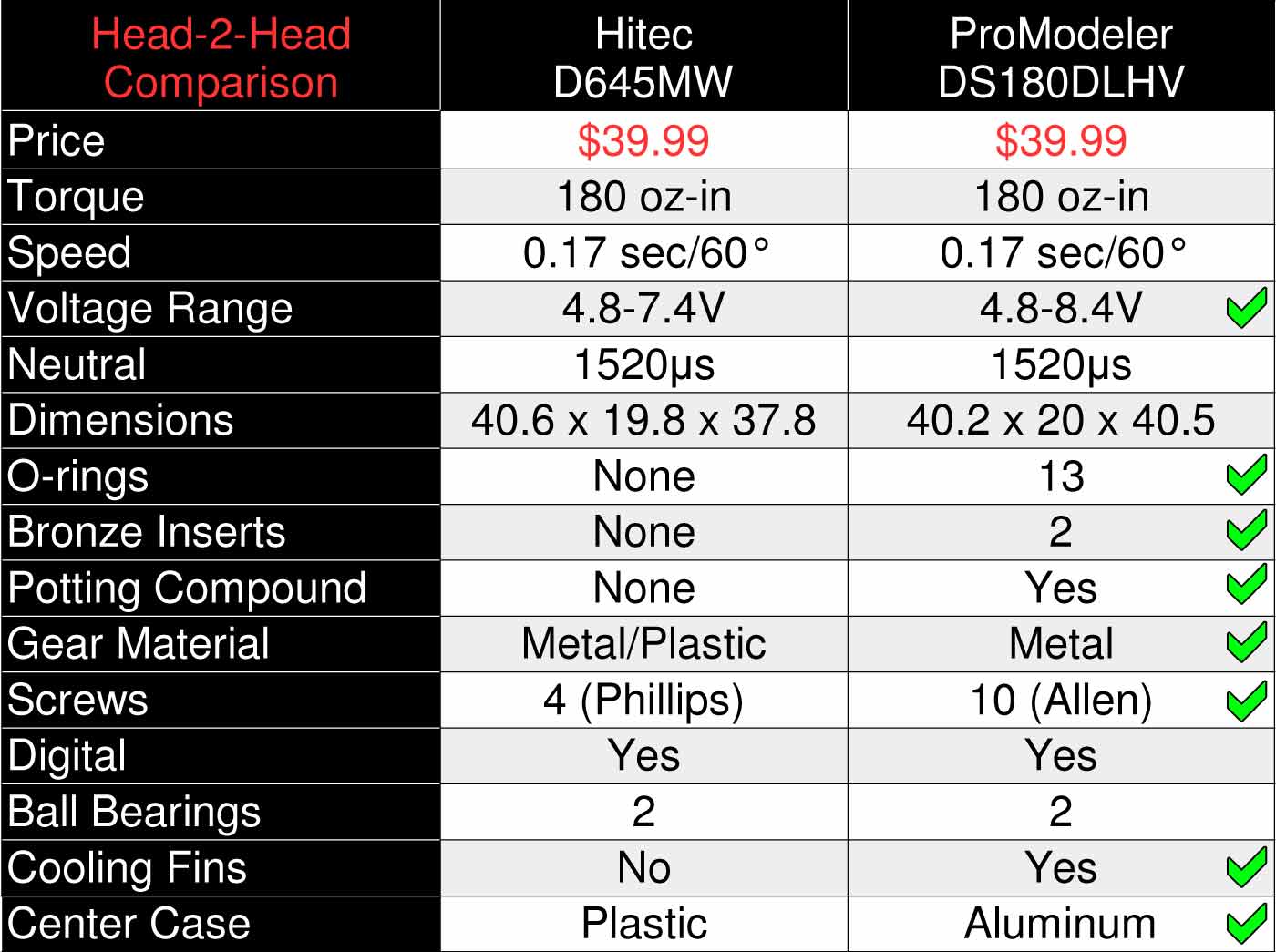
 Next up is the Hitec HS-5646WP. It's another standard-size digital-servo in their vast lineup and it more seriously
competes with the DS180DLHV because it's waterproof. This is great if
you ever develop a interest in flying off water, believe us. Flying off water is almost as much
fun as sex (just kidding, but barely). Meanwhile, performance is about the same-same as their
other versions (and about the same as ours). Yes, the speed drops a skosh (6%) but this
isn't anything worth writing home about. They even keep the plastic gear
within an otherwise metal gear train (once again, same part number).
Next up is the Hitec HS-5646WP. It's another standard-size digital-servo in their vast lineup and it more seriously
competes with the DS180DLHV because it's waterproof. This is great if
you ever develop a interest in flying off water, believe us. Flying off water is almost as much
fun as sex (just kidding, but barely). Meanwhile, performance is about the same-same as their
other versions (and about the same as ours). Yes, the speed drops a skosh (6%) but this
isn't anything worth writing home about. They even keep the plastic gear
within an otherwise metal gear train (once again, same part number).
However,
there's a rub. Hitec wants this servo to go back to their
service center any time you need the little plastic gear (or the case).
Remember, they sell the plastic gear in 3-packs so it wouldn't be
unreasonable to
conclude it's somewhat fragile. Add in for postage (plus the delay before you get it back from their service center) and you better think long and hard
about getting married to this servo. Especially because this one also commands a hefty price premium of $55
vs. $40 (28% more expensive). This isn't quite 3-servos for the price of 2 but it's close.
On
top of all this, theirs sports an all-plastic case, no conformal
coating, and no bronze inserts for reinforcing the case where the steel
gear shafts fit the pockets and once again we believe the DS180DLHV wins
(going away).
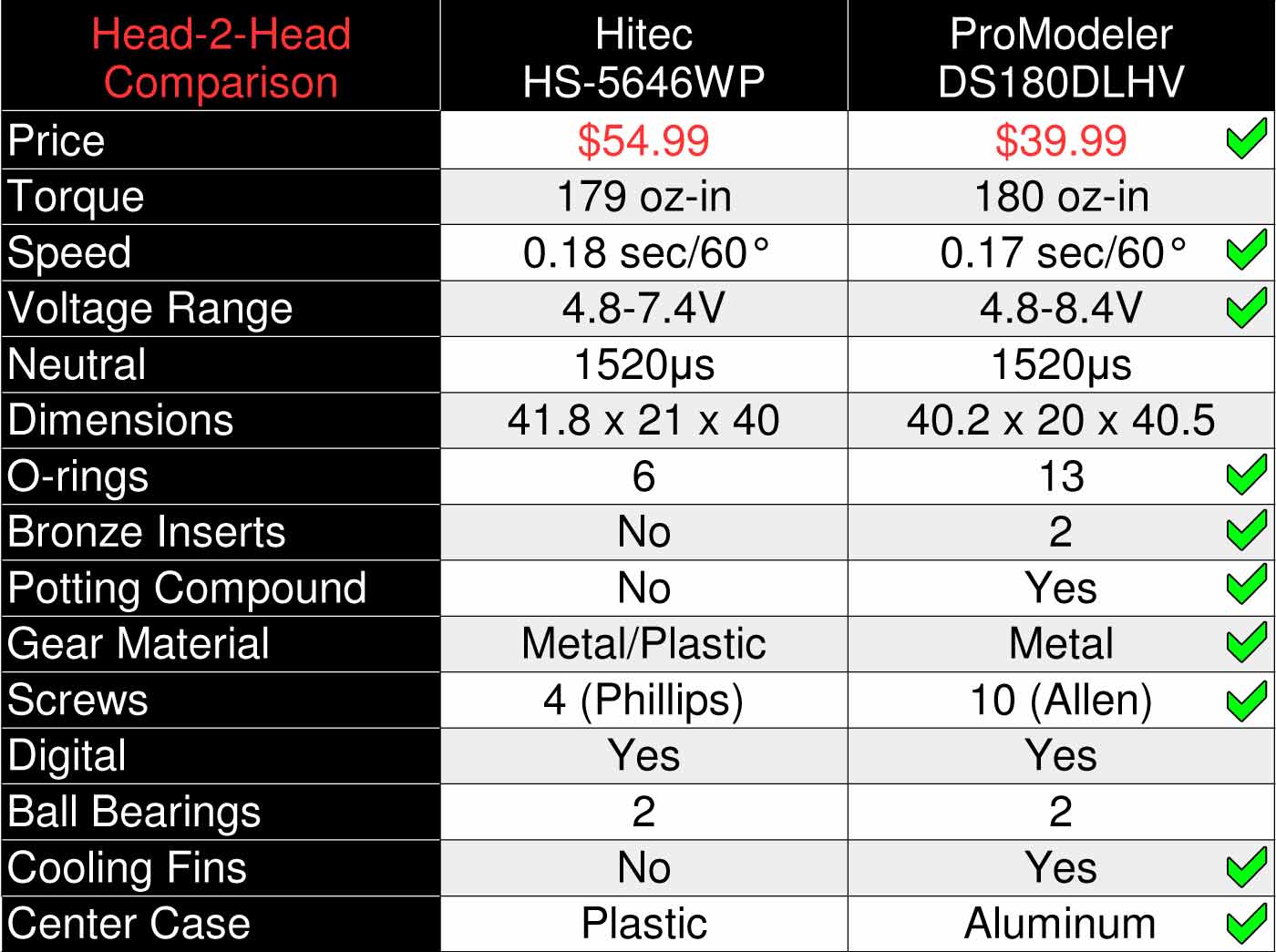
 This
brings us to the Spektrum A-6150, which is another worthy competitor to the
DS18DLHV. It outputs the same 180oz-in as the DS180DLHV
but it's faster, which can be important for
some applications. It even has a metal center section plus it's 3
bucks cheaper! Better deal? Not so fast!
This
brings us to the Spektrum A-6150, which is another worthy competitor to the
DS18DLHV. It outputs the same 180oz-in as the DS180DLHV
but it's faster, which can be important for
some applications. It even has a metal center section plus it's 3
bucks cheaper! Better deal? Not so fast!
Let's
begin with the gear train. They say 'metal' but if you investigate, it's metal and
plastic (look up their part #SP1003). And there's a catch because according to their website the
gear set won't be available until sometime in 2018 - hmmm. Conversely,
when we say metal gears we're not bullshitting you. Plus replacement gear sets are available if you want them without waiting.
Next,
let's discuss the metal center section. Theirs is an aluminum extrusion
(formed just like a window frame is squeezed through a die - exact same
process).
And it doesn't have cooling fins. Ours? We begin from a forged billet
of 6061-T6 aircraft aluminum and CNC-machine it to the final form -
complete with cooling
fins. Why is this important? Basically, the servo motor will last longer
(when the servo is being worked hard) because the fins help it shed heat
faster. Maybe this doesn't matter to you, but there are other factors
that may.
For example, instead
of four long Phillips head screws, which totally bypass the aluminum
because their extruded aluminum center is merely sandwiched between the
plastic bottom and
the plastic
top pieces (that's right, the screws thread into plastic), our aluminum
center
has ten holes tapped for fine-thread Allen head machine-bolts. Thus,
the center case of ours is the foundation to which the plastic pieces
attach. Do you grok the difference? Our servo is a Hell of a lot stiffer
meaning that under load the gear mesh doesn't vary - at all. Especially
because we us 10
vs. 4 screws (to say nothing of Allen being better than Phillips heads).
But there's more.
For example, the metal gears are fitted
to steel shafts, right? These tiny steel shafts fit into plastic pockets
within the servo
top. Over time they become egg shaped due to the loads being imposed.
They sell you a replacement case (we do also) but our plastic bits are
better because we reinforce the gear component with bronze inserts. Why?
It's because as experienced modelers know, the
working life of a servo can easily exceed 10 years. Since the bronze
inserts
are much harder than plastic (meaning they won't wear away like
plastic) this means you can depend on a much longer service life. Is
this worth an extra three bucks? It's your call but we think this is
something of a no-brainer because what if you can't find parts for their
case in
10 years? Just saying.
Bottom
line? These days metal gears doesn't really mean all-metal, and all
servos with an aluminum center case aren't equal, either. Basically,
today's marketing guys practice a sharp
form of word-smithing that means you have to be careful, or put another
way, all that glitters isn't gold!
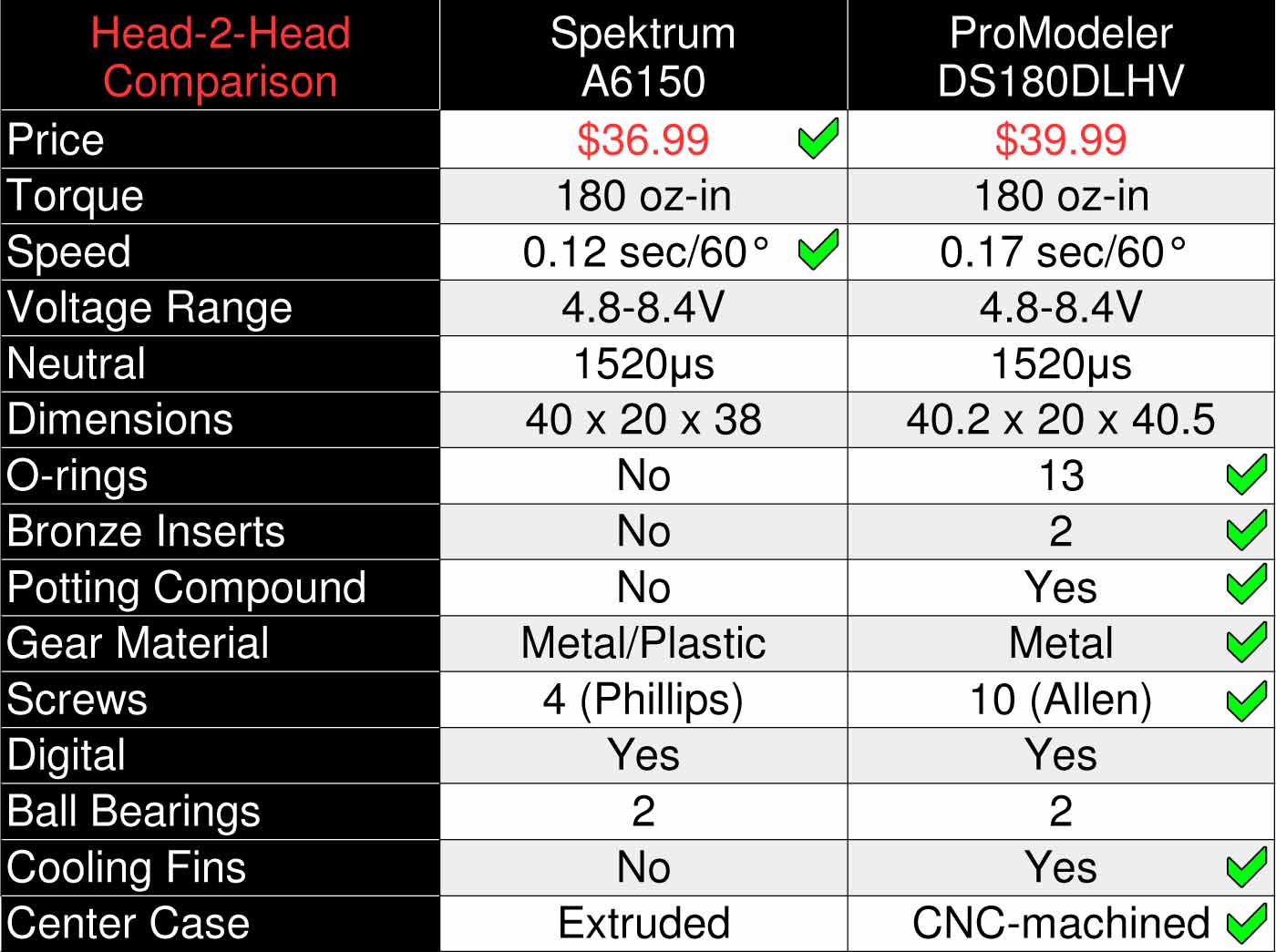
 In closing, unlike hobby-grade servos,
the DS180DLHV servos are built to a higher standard. They meet MIL-STD-810G-Part 16 (Vibration) Test Method 514.6 as well as Test Method 516.6
(shock) because like you, we know all about impact from crashes and
engines vibrations that propagate throughout an air frame! This is why
our
PCB (printed circuit board) has a conformal coating (potting compound in
the civilian world), it's why we reinforce the gear case with bronze,
and it's why we CNC-machine the center fro aircraft aluminum. You won't
find this level of detail in the above Spektrum servo, or the ones from
Hitec and Futaba. When we suggest ours is built better, we back it up.
It's your money, choose wisely.
In closing, unlike hobby-grade servos,
the DS180DLHV servos are built to a higher standard. They meet MIL-STD-810G-Part 16 (Vibration) Test Method 514.6 as well as Test Method 516.6
(shock) because like you, we know all about impact from crashes and
engines vibrations that propagate throughout an air frame! This is why
our
PCB (printed circuit board) has a conformal coating (potting compound in
the civilian world), it's why we reinforce the gear case with bronze,
and it's why we CNC-machine the center fro aircraft aluminum. You won't
find this level of detail in the above Spektrum servo, or the ones from
Hitec and Futaba. When we suggest ours is built better, we back it up.
It's your money, choose wisely.
A $30 DS130DLHV costs about $23 to make. A good quality competitor
like a Hitec HS-5625MG also sells for $30 - while costing maybe $7. The
reason a $7 servo sells for $30 is due to a focus on making and pricing a
product with a business model that prizes putting the product on
display in the hobby shop. We figure folks would rather receive more
servo for their money and buy off the internet. It's why Amazon
succeeds. Same with us and thus, instead of ponying up for a
US-importer, who sells them to a distributor, who sells them to hobby
shops, who in turn sell them to you (e.g. such that everybody gets a cut
while you pick up the tab), with ProModeler you're dealing direct!
Of
course, this isn't rocket science. The Hitec is a pretty good servo but realizing how the game is played thrifty modelers off-brand metal gear servos for $14 because they receive pretty much the
same $7 servo while paying about what the importer pays. But they're taking a risk in buying junk. Meanwhile
savvy customers buy from us because it's obvious we spend 3.5X more on
making a better servo. If you prefer a better servo to a cheaper servo,
then for the same $30, you get a Hell of a lot more servo for your
money. This is the formula and it's a no brainer.
Better components.
Better servos. The formula is simple.
Most
of us have felt that lurch of panic as we dropped a servo during
installation and snatched it off the floor to inspect for damage. It's
this shared experience as modelers, which led us to build the DL-family
of servos to an aerospace-standard.
For example, to better
mitigate against shock (and vibration), we use what the military refer
to as a conformal coating to protect the delicate electronics
components mounted on the PCB (printed circuit board), Compared to the
square of foam rubber used in hobby-grade servos, we call the white
stuff smeared over the electronic components monkey snot because it's
such a sticky mess to deal with during application. Which do you think
is better?
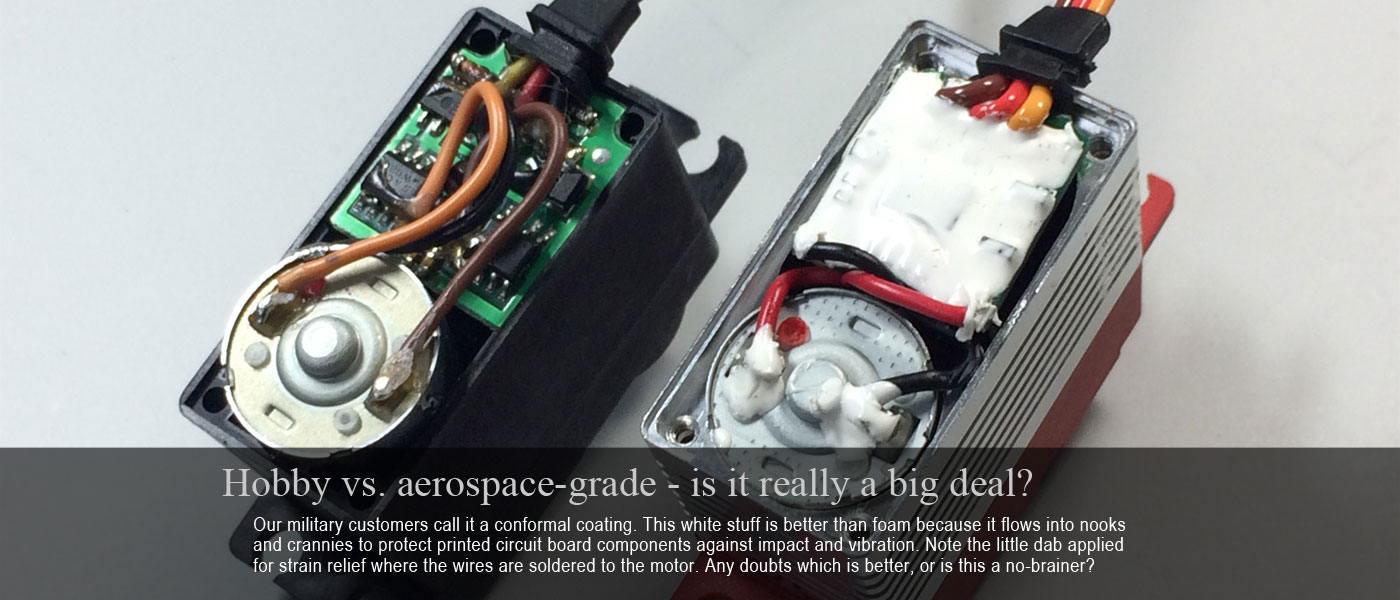

Anti-vibration and impact protection are a big deal to our military
customers. Perhaps you aren't flying a $100,000 UAV, but if you want
better servos, since monkey snot is a consideration for the military, it's probably important to you also.
Also important is how we use
MIL-SPEC components - plus the best motors and potentiometer money can
buy. These are critical for the best centering performance possible. Yet
nothing is quite so telling as this simple fact . . . you can actually
buy these components from us. Unlike hobby-grade servos where they only offer cases and
gears and require you to spend big money to really bring your servos back up to
snuff (basically, they're telling you to throw them away when the repair bill is nearly as much as replacing the servo), you've discovered another reason pros prefer ProModeler.
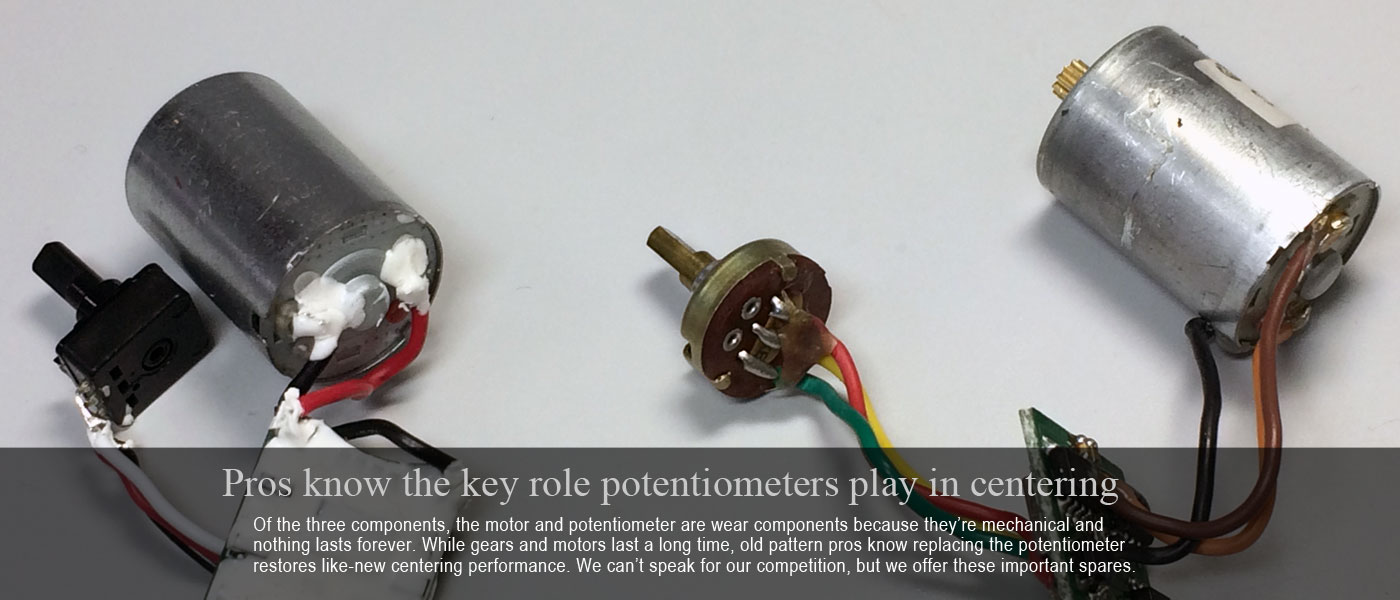

Meanwhile, do you
believe in better engineering? We do too. Unfortunately, unless you open
it up to look after buying, the other guys don't make it very easy to
know what you're actually getting. We show you and if you appreciate attention to
detail, this is yet another thoughtful touch - the bronze bushings reinforcing the
gear shaft pockets. This is one of those details that ensures your investment in
these servos delivers value.
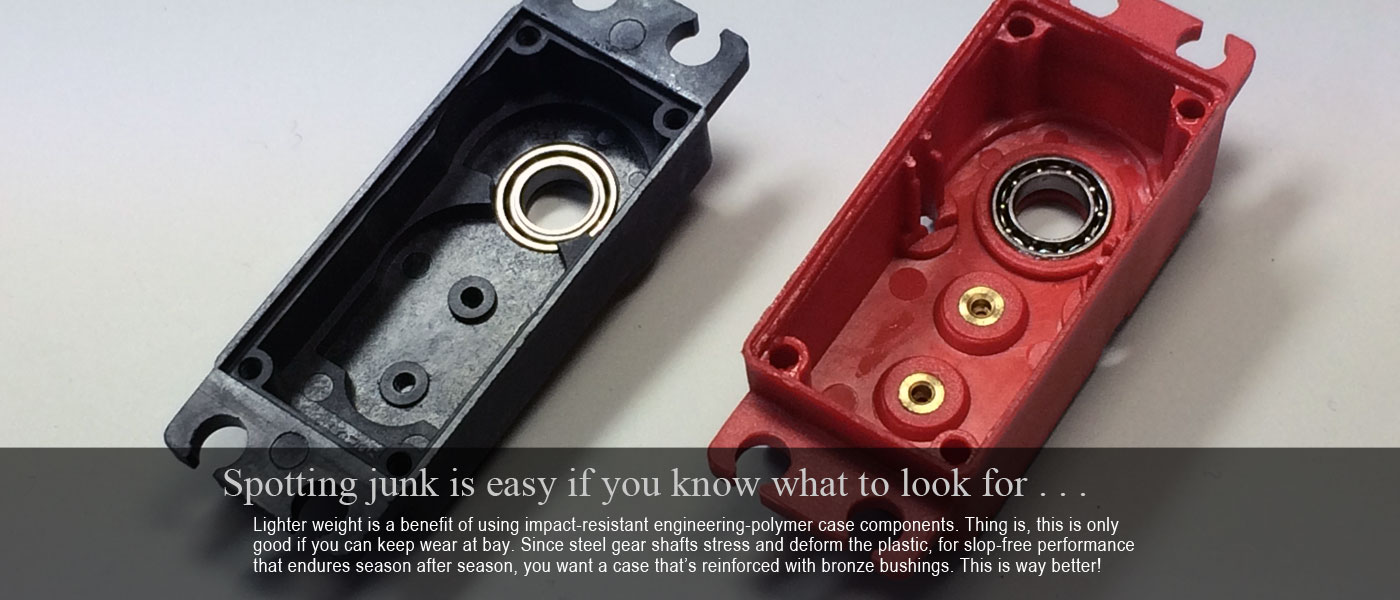

To
recap, not only is the molding for the polymer pocket more robust in a ProModeler servo case, but the bronze inserts reinforcements are there so your servos
will last, and last, and last! Bottom line? Understanding the
difference between something's price and its value comes down to
grokking the details.
Along the same lines, a big difference for
why experienced modelers prefer ProModeler servos versus something priced
about the same is found in how the center section is made. Ours is the one on the left. It's CNC-machined from a solid billet of 6061-T6 aluminum and the motor cools better when you're working the
servos hard because it transfers heat better and because of the fins, sheds heat more quickly. And note, it's
drilled and tapped to accept fine thread machine-screws for the ultimate
in rigidity.
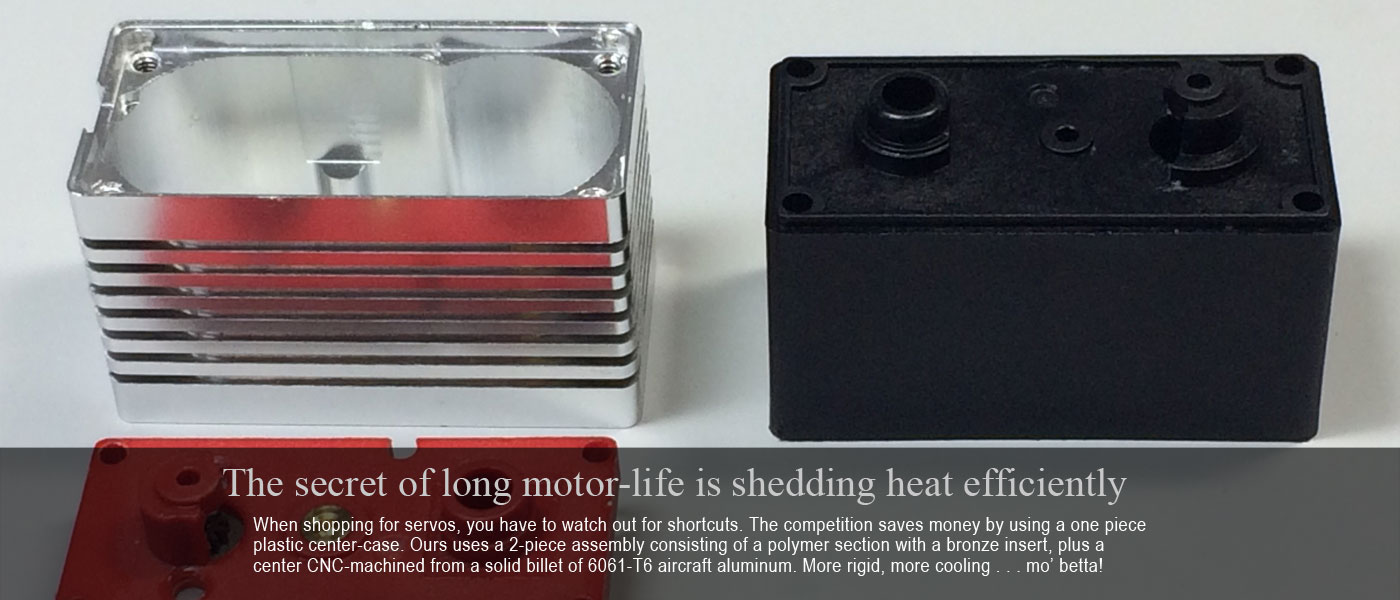

Finally,
eyeball all the major components laid out side-by-side. We suspect it's
rather easy to see why your next set of servos should be from
ProModeler. If you're sharp eyed you'll have noted the
assembly uses 10 Allen-head bolts with machine-threads instead of 4
Phillips head screws with cheese-cutter threads that go into plastic.
You'll see how each bolt has
an o-ring beneath the head - and - that it threads into aluminum instead of plastic. You also
also know to look out for gears represented as metal but which include a
plastic gear so fragile they sell replacements in 3-packs. You also
understand that servo manufacturers that shove a cheap piece of foam
beneath the electronics cover and call it good aren't just shortchanging
you, but playing roulette with your model by paying less than perfect
attention to vibration protection.
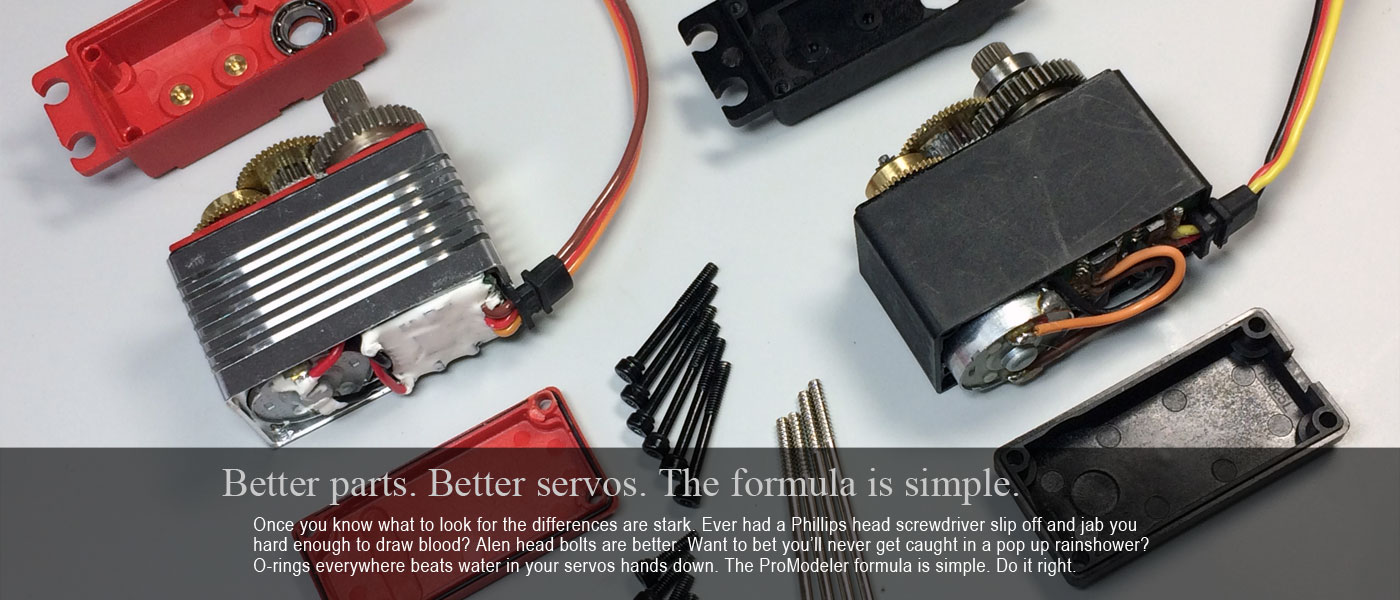

As you get a better idea of what to look for, you buy smarter. It's as
simple as discerning the differences between hobby-grade and
professional-grade. So let's tie it all together. Better parts. Better servos. The formula is simple. It's
a no-brainer and paying the same, or more, for another brand just
because it's what others do is a non-starter with savvy modelers. These are the servos you want for your next model.
Overall Customer Rating of 11 Reviews: